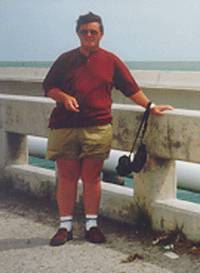Positive Health Online
Your Country

Dieting - A Recipe for Failure
listed in nutrition, originally published in issue 36 - January 1999
Dieting, like conventional medicine, works on the expectation of failure. Conventional medicine is designed to deal with ill health and it factors in a high drop out or death rate. The slimming business is dependent on repeat customers and assumes that 95% of its clients will relapse and require further help. And, sure enough, only 5% of dieters actually do manage to maintain their weight loss.
Within a year, or sooner, the rest will re-gain the weight they fought so hard to shed – and usually more. Not just once, but over and over again. The desperate dieter, willing to spend money on books and magazines, on classes and even on drugs when nothing else seems to work, guarantees the slimming industry a profit of more than £1 billion a year in the UK. In America, the third fattest country in the world, billions of dollars are spent on the losing battle against obesity.
Even more depressing is the fact that the commercial diet companies are thriving on the profits of failure they actually help to create and maintain. Like tobacco, the product fosters its own demand. Dieting is one of the main causes of obesity and eating disorders.

Before

After

Before

After
Feeding the obsession
Dieting is obsessional behaviour. It's not normal behaviour. And most conventional diets cleverly encourage the obsession – prompting slimmers to count calories, think about what they can't eat and combine food in complicated ways. Focusing on the problem like this feeds the obsession as well as the fat cells.
There was a famous study in the 1940s by the University of Minnesota. A group of psychologically healthy men of normal weight were put on a diet that, like many currently popular diet plans, cut their daily calorie intake in half. The men were closely monitored and over a 12 week period they lost significant amounts of body weight. The average rate at which their bodies digested food also dropped by 40% because their bodies believed they were experiencing famine.
When the diet finished, it took, on average, 14 months for the men's weight and metabolism to return to normal. And, during that period, every single one of them displayed anorexic, bulimic or binge-eating behaviour patterns. They had distorted their bodies' natural weight regulation mechanism and their metabolic systems were out of control.
To start with, they regained the lost weight plus about 10% extra. And the first weight they put back was in the form of fat, not muscle.
Eventually, their weight normalised and their percentage of body fat dropped back to their pre-diet levels. But they were being watched and regulated and controlled. They were reassured by the fact that they knew they were part of an experiment. Most dieters today would panic if they gained back the weight they'd lost and another 10% on top. In fact, most dieters today do panic, because that's exactly what happens to most of them when they stop dieting. And, when people are alarmed, they tend to take drastic action - like starting another diet when the balance of their metabolism is still disturbed from the last one.
Don't think of a pink elephant
The human mind tends to get what it focuses on. We delete negatives. So, if I tell you not to think of a pink elephant, guess what happens? Most people who go on a diet are saying to themselves: "I must lose half a stone, I wish I wasn't so fat, I've got to get rid of this cellulite...". They'd do a lot better if they started to think about being slimmer and fitter, feeling better, running faster, having more fun, looking good, enjoying better health.
If you spend a lot of time watching your weight, that is usually what you get. More weight. Pretty soon you'll have convinced yourself that you're a naturally fat person and eventually you'll start behaving like one. After all, if you have a tendency to put on weight, you must be the sort of person who wants to eat a lot, right? You eat because you've got no will power and low self esteem, low blood sugar and nobody loves you because you look like one of the Teletubbies...?
And of course, when you get to that stage you aren't going to exercise. You get breathless when you climb stairs, your knees hurt when you jog (not surprising when they're carrying more weight than they were designed to) and you don't look good enough in a leotard to go to the gym. Relax, don't do it
Relax, don't do it
Dr Jim Hill, Co-Director of the National Weight Loss Registry studied a sample of the 5% of dieters who maintained a 30lb weight loss for more than a year and came to the conclusion that: "These folks have found the secret of being able to incorporate exercise into their lives."
Taking more exercise is much better than dieting when it comes to losing weight. We don't actually eat more than we did 30 years ago, in fact we eat less. But we're becoming more and more sedentary and our bodies, which were designed to move, are suffering.
Inactivity is being sold to us as a desirable way of life. A way of life which will require us to buy more machines and more labour saving products. The key word for the last few decades has been RELAX. Taking a break usually conjures up images of sitting down with a chocolate bar or a drink and letting every muscle de-contract. Doing nothing is seen as a treat. Even when it comes to earning a living, jobs which involve physical work are generally poorly paid and have lower status than ones which involve sitting down with a phone or a VDU.
Meanwhile, everybody talks a lot about exercise. Health clubs seem to be springing up everywhere. But most people stop participating in sport when they leave school and spend the rest of their lives watching it on a television screen. Even getting out of the house and going to a match is more of an effort than most of us are prepared to make. We drive our children to school (although we worry abut the air pollution) and then we drive them home from school and sit them in front of the television instead of taking them out to play. Even the glamorous fitness centres make more money out of the people who pay their fees and don't use the facilities than they would ever care to admit.
Just Do It?
There's a famous sportswear advert which encourages people to pull on their trainers and run. It also manages to subtly imply that exercise isn't normal behaviour, that you have to be rather a special human being with a budget for expensive shoes to be able to do it.
That message has fooled a lot of people into either spending a fortune on trainers or giving up exercise altogether. But the truth is that the kind of activity which turns you into a fat burning machine isn't the kind that requires special training, special equipment, or a special environment. So from the point of view of the slimming and sports industries it's not going to generate much in the way of profit. And advertising budgets aren't going to be spent on encouraging people to walk to the shops or cycle to the post office.
Pleasure and Pain
But we can't blame big business and the media for everything – including our own surplus fat. The first step to staying slim is to take responsibility for our bodies and our lifestyles instead of buying somebody else's ideas.
Our behaviour is governed by pleasure and pain – we generally seek pleasure and try to avoid pain. Unfortunately, we've programmed ourselves to think that exercise is painful. Remember Jane Fonda and the No Pain, No Gain slogan? It's like medicine, if it doesn't taste bad it can't be good for you. The 5% of dieters who succeed have done it by changing their pain and pleasure associations. They've started enjoying regular exercise and making it part of their lives instead of just forcing themselves to do it twice a week. And once they start enjoying their new pattern, I've found they generally discard the diets. When your life is full of pleasurable activity, you just don't have time to weigh out every item on your menu and your mind's too busy to think about your next meal until you're ready to eat it.
Helena, one of my clients, said recently "I believed that losing weight was difficult and exercise was hard work, but after 12 weeks with Pete I thought exercise was fun and I was losing weight effortlessly."
That's not because of something I did for her or to her and I certainly didn't get her to weigh herself or count calories or take pills. I showed her how to enjoy exercise and get pleasure from activity rather than eating. That's all.
The 95% of failed dieters don't exercise. They hated it at school and they know those bad feelings are going to flood back if they go to step class. They also know that they'll never be good enough at squash to get a partner, that they can't join a health club because only fit people go to them and that they haven't got time to work out because work's so demanding. Most of all, they know that the only kind of exercise that will help them to lose weight is going to be very painful.
And what about those people who actually are disciplined enough to drag themselves out of bed and put themselves through hell for an hour every other morning? Well, the first thing I do is try and talk them out of it. I remember one middle-aged, overweight executive rounding on me when I told him to slow down at the club one morning. "Call yourself a fitness instructor?" he said. I tapped his heart monitor and tried to explain that the rate he was working at meant that he was probably burning sugar not fat. He wasn't listening – the only voice he could hear was the one in his head promising him croissants and cappuccino as a reward when he got through the shower. He certainly didn't want to hear me telling him to walk comfortably to work and have a bowl of fruit and muesli to keep him going to lunchtime. Where's the glamour in that?
When we push ourselves to the point of pain and distress, and, believe me, I see people doing it all the time, we risk permanent damage. The pain we are subjecting our bodies to is being permanently recorded in our nervous system and we aren't even burning fat in the most efficient way.
So, if most people assume that exercise is only useful if it's painful, and then, when they make themselves do it they find it doesn't even work, doesn't dieting suddenly look like an attractive alternative? After all, you can do calorie counting, pill popping and wacky eating plans in the comfort of your own kitchen.
Take it easy
The kind of exercise you pay for is often at somebody else's pace, not your own. When a fat person starts gasping for breath because he or she is trying to keep up with the instructor at the front of the class, they aren't getting oxygen to their muscles. Their bodies are trying to maintain the status quo by saving fat and burning sugar instead. Steady, comfortable exercise, for fifteen minutes at a time, as a part of the daily routine, not only burns fat, it multiplies the fat burning enzymes in the muscles. Fit people burn more fat, even when they are sitting down, than fat people do. Their muscles are great fat burners. Everybody can be fitter if they take it easy and do it often – use your muscles regularly and with respect and you'll change your metabolism.
Besides, if you're doing something because you enjoy it and it fits into your routine – like learning to tango or taking the children to the park – you're more likely to keep it up, aren't you?
Eating For Fun
So, once I've shown my clients that it's possible to enjoy exercise – as I do – my next task is to help them find ways of being happy that don't involve cake (or pizza, or beer, or chocolate...).
The trouble with eating is that, like sex, it's fun as well as being necessary for survival. There's nothing wrong with enjoying food. In fact I think it's a good idea. A lot of desperately overweight people don't actually enjoy food very much, that's why they can eat so much junk. They feel too guilty to even taste it as they shovel it down.
For many people, food is their only source of pleasure instead of one among many as it should be. Children are given sweets as a reward, we have meals to celebrate weddings and birthdays and 'Comfort Food' is one of the new phrases in the thesaurus.
Back to the blueprint
I teach my clients to get back to their own natural blueprint. The one they lived by when they were a baby and didn't know any worse. Learning to eat when you're hungry and move around most of the time when you're awake. It's surprisingly easy to re-learn those good habits you were born with.
The Final Round Up
If you're a regular reader of Positive Health, you already know about all the benefits of not being overweight. Obesity has been linked to some major killers including heart disease, some cancers and diabetes. So anything that helps people lose weight must surely be a good thing? Is it really fair to say that dieting causes obesity and eating disorders?
I was speaking to the headmistress of a well-known girls' school the other day. "Twenty years ago," she said, "the fourth form were smoking in the toilets during break. Now they're throwing up their lunch. And it's starting in the third form too. They're still children, and it's affecting them for life."
My clients aren't all women with middle aged spread. Many of them are far too young to be worrying about whether they've consumed 725 calories or 850 calories in a day – and a lot of them are men. What I want to say to them is "Get a life." But I know that's not going to help.
When somebody joins one of my classes, they often ask me two questions: "Are you going to weigh me?" and "Do we get calorie counters?". The reaction when I tell them "No" to both is usually disbelief, annoyance and frustration. That used to surprise me. I thought they'd be relieved. But dieting's a hard habit to break. People get totally dependent on living by somebody else's rules. Now, I'm not saying that all diets are dangerous, though some currently popular ones would be if they weren't too complicated to follow. But even the sensible, nutritionally sound diets can make sure an overweight person stays focused on weight and start a thin one on the slippery slope to obsession.
The only way to be the weight you want is by listening to your own body. It's telling you when to eat. It's even telling you what to eat. And it's definitely telling you to get up and get out and move. If you are listening to instructions from somewhere else, you won't be able to hear yourself think.
Mental Exercises
There are a few little things I do that seem to help my clients a lot. They are all based on the principle that the only way to lose weight is to get back in touch with what your body needs and learn to enjoy eating and exercising all over again.
It seems a shame that we've got to the point where we have to pay someone else to tell us how to do the two most natural activities in the world – eating and exercising.
The Hunger Scale
I've asked people who are just about to put a slice of pizza into their mouth "Are you hungry?" and they look at me as if I'm mad. But when they stop and think about it, very often they can't honestly answer "yes."
We eat because it's lunch time or we're bored or just because we always have a biscuit when we do the crossword. When we stop and think about it, we may find that what you want at that precise moment isn't a bag of crisps but a cuddle or a walk or even a glass of water.
If you eat when you are not hungry, your body will turn whatever you eat into fat. If you don't eat when you are hungry, your body thinks it's being starved and uses your muscles for fuel and energy, hanging on to the precious fat reserves for when things get really tough.
The Hunger Scale is simply a set of questions you get into the habit of asking yourself.
Question One: Am I hungry?
Question Two: If I'm not hungry, what am I?
Question Three: How hungry am I on a scale of one to ten?
Answering these questions with your stomach as well as your head takes a bit of practice. But it's surprising how quickly you can get the feel for it.
Think Before You Eat[1]
The second exercise I suggest is a bit more substantial than asking yourself if you're hungry. It's more like a thought process you get used to running before you decide to eat. It follows on very neatly from the Hunger Scale.
* When you think about eating, take a minute to ask yourself whether you have any physical symptoms of hunger, or whether, perhaps you could just be tired or restless.
* If you can identify some sensations, maybe in your stomach, that might make you think you rate 5 or more on the Hunger Scale, ask another question. What would satisfy your hunger?
* What image do you get? Is it an orange? A toasted ham and cheese sandwich? A plate of chips?
* The next step is to imagine eating the food that comes to mind and try to get as many of your senses involved as possible – taste it, smell it and look at it carefully.
* If that food that you're imagining is making you feel better already, make a mental note of it. But if you don't think that the tomato salad will do the trick, leave it off the list. Do this a few times until you've got a selection to choose from.
* Now, run through those choices to see what effect each one would have on you over the next few hours. Would it feel good in your stomach? Would you feel empty, bloated, uncomfortable?
Finally make your choice. Don't just try this exercise once. Try it every day for a few weeks, you'll find it becoming second nature very fast. I've met a lot of people over the last ten years when I've been working in health clubs and the slim ones usually have their own version of Think Before You Eat hard wired into their brains. People who are overweight, or think they are, on the other hand, can be randomly triggered to eat by all sorts of irrelevant stimuli, seeing an ex boyfriend, winning £10 on the lottery, or even just walking into the kitchen.
References
1. Connirae Andreas, The Heart of the Mind. Real People Press, 1989.
Comments:
-
No Article Comments available